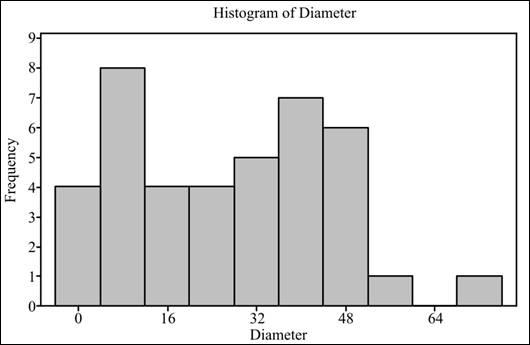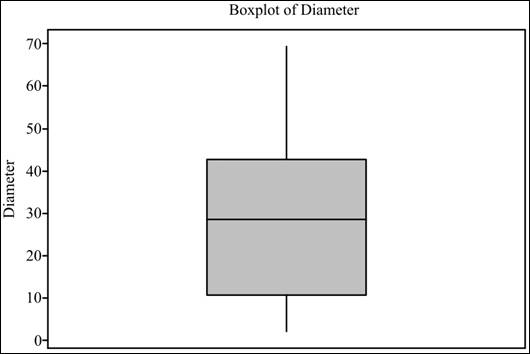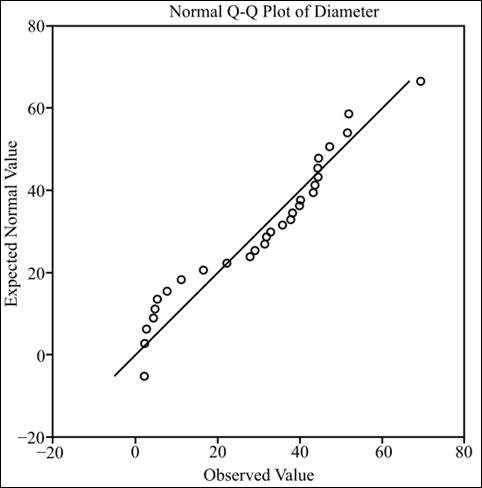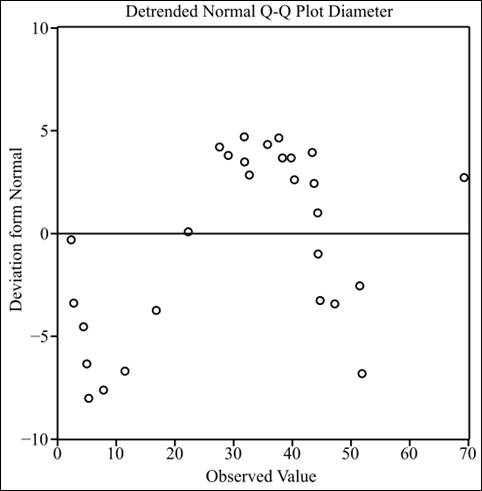
(a)
To graph: The histogram.
(a)
Explanation of Solution
Calculation:
To draw the histogram, follow the below mentioned steps in Minitab:
Step 1: Enter the data in Minitab and enter variable name as “Diameter.”
Step 2: Go to “Graph” and point on “Histogram.” Click on “Simple” and then press OK.
Step 3: In dialog box that appears, select “Diameter” under the field marked as “Graph variable,” and then click on OK.
The histogram obtained is as follows:

Interpretation: The histogram does not seem to represent a bell-shaped curve.
To graph: The box plot.
Explanation of Solution
Graph: To draw the box plot, follow the below mentioned steps in Minitab:
Step 1: Enter the data in Minitab and enter variable name as “Diameter.”
Step 2: Go to
Step 3: In dialog box that appears, select “Diameter” under the field marked as “Graph variable,” and then click on OK.
The required box plot is as follows:

Interpretation: From the box plot, the data does not appear to be symmetrical.
To graph: The normal quantile plot.
Explanation of Solution
Given: The data for the diameters of 40 randomly sampled trees is provided.
Calculation: To draw the normal quantile plot, follow the below mentioned steps in SPSS.
Step 1: Enter the data of diameter in SPSS and enter the variable name “Diameter.”
Step 2: Go to
Step 3: Select “Diameter” under the field marked as “Variables.” Finally, click on “Ok.”
The normal quantile plots are as follows:


To explain: The distribution.
Answer to Problem 31E
Solution: The distribution is not normal as it has two peaks, and the normal quantile plot shows that the distribution is deviated from the
Explanation of Solution
The histogram of the distribution shows that it has two peaks. In the box plot, the upper tail is longer than the lower tail, which indicates its deviation from normality, and the normal quantile plots also show that the data is deviated from the normal distribution as most of the values are away from the normal position.
(b)
Whether t procedures can be used to calculate 95% confidence interval.
(b)
Answer to Problem 31E
Solution: The t procedures can be used as the sample is large enough to eliminate the effect of non-normal distribution.
Explanation of Solution
As the data is large enough as compared to the population, it will eliminate the effect of non-normality. So, the t procedures can be used.
(c)
Section 1:
To find: The margin of error.
(c)
Section 1:
Answer to Problem 31E
Solution: The margin of error is 5.68.
Explanation of Solution
Calculation:
To calculate the margin of error, first, standard deviation and
Step 1: Enter the data in Minitab and enter variable name as “Diameter.”
Step 2: Go to
Step 3: In dialog box that appears, select “Diameter” under the field marked as “Variables,” and then click on “Statistics.”
Step 4: In dialog box that appears, select “None” and then “Mean” and “Standard deviation.” Finally, click on “Ok” on both dialog boxes.
From Minitab result, the standard deviation is 17.71 and the mean is 27.29.
The formula for margin of error is as follows:
where
Section 2:
To find: The 95% confidence interval for mean diameter.
Section 2:
Answer to Problem 31E
Solution: The 95% confidence interval is
Explanation of Solution
Calculation:
The confidence interval is an interval for which there are 95% chances that it contains the population parameter (population mean).
To calculate confidence interval, follow the below mentioned steps in Minitab:
Step 1: Enter the provided data into Minitab and enter variable name as “Diameter.”
Step 2: Go to
Step 3: In the dialog box that appears, select “Diameter” under the field marked as “sample in columns.” Click on “option.”
Step 4: In the dialog box that appears, enter “95.0” in confidence level and select “not equal” in “Alternative hypothesis.”
From Minitab results, 95% confidence interval is
Interpretation: The 95% confidence interval is
(d)
Whether the result found in parts (a), (b), and (c) would apply to the trees in the same area.
(d)
Answer to Problem 31E
Solution: The result would not apply to the trees in the same area because the sample size was small and the data was also not normal.
Explanation of Solution
The sample size must be large to conclude about the population but here the sample size was not large enough to conclude about the trees in the same area. Therefore, the result would not be applied to other trees in the same area.
Want to see more full solutions like this?
Chapter 7 Solutions
EBK INTRODUCTION TO THE PRACTICE OF STA
- For a binary asymmetric channel with Py|X(0|1) = 0.1 and Py|X(1|0) = 0.2; PX(0) = 0.4 isthe probability of a bit of “0” being transmitted. X is the transmitted digit, and Y is the received digit.a. Find the values of Py(0) and Py(1).b. What is the probability that only 0s will be received for a sequence of 10 digits transmitted?c. What is the probability that 8 1s and 2 0s will be received for the same sequence of 10 digits?d. What is the probability that at least 5 0s will be received for the same sequence of 10 digits?arrow_forwardV2 360 Step down + I₁ = I2 10KVA 120V 10KVA 1₂ = 360-120 or 2nd Ratio's V₂ m 120 Ratio= 360 √2 H I2 I, + I2 120arrow_forwardQ2. [20 points] An amplitude X of a Gaussian signal x(t) has a mean value of 2 and an RMS value of √(10), i.e. square root of 10. Determine the PDF of x(t).arrow_forward
- In a network with 12 links, one of the links has failed. The failed link is randomlylocated. An electrical engineer tests the links one by one until the failed link is found.a. What is the probability that the engineer will find the failed link in the first test?b. What is the probability that the engineer will find the failed link in five tests?Note: You should assume that for Part b, the five tests are done consecutively.arrow_forwardProblem 3. Pricing a multi-stock option the Margrabe formula The purpose of this problem is to price a swap option in a 2-stock model, similarly as what we did in the example in the lectures. We consider a two-dimensional Brownian motion given by W₁ = (W(¹), W(2)) on a probability space (Q, F,P). Two stock prices are modeled by the following equations: dX = dY₁ = X₁ (rdt+ rdt+0₁dW!) (²)), Y₁ (rdt+dW+0zdW!"), with Xo xo and Yo =yo. This corresponds to the multi-stock model studied in class, but with notation (X+, Y₁) instead of (S(1), S(2)). Given the model above, the measure P is already the risk-neutral measure (Both stocks have rate of return r). We write σ = 0₁+0%. We consider a swap option, which gives you the right, at time T, to exchange one share of X for one share of Y. That is, the option has payoff F=(Yr-XT). (a) We first assume that r = 0 (for questions (a)-(f)). Write an explicit expression for the process Xt. Reminder before proceeding to question (b): Girsanov's theorem…arrow_forwardProblem 1. Multi-stock model We consider a 2-stock model similar to the one studied in class. Namely, we consider = S(1) S(2) = S(¹) exp (σ1B(1) + (M1 - 0/1 ) S(²) exp (02B(2) + (H₂- M2 where (B(¹) ) +20 and (B(2) ) +≥o are two Brownian motions, with t≥0 Cov (B(¹), B(2)) = p min{t, s}. " The purpose of this problem is to prove that there indeed exists a 2-dimensional Brownian motion (W+)+20 (W(1), W(2))+20 such that = S(1) S(2) = = S(¹) exp (011W(¹) + (μ₁ - 01/1) t) 롱) S(²) exp (021W (1) + 022W(2) + (112 - 03/01/12) t). where σ11, 21, 22 are constants to be determined (as functions of σ1, σ2, p). Hint: The constants will follow the formulas developed in the lectures. (a) To show existence of (Ŵ+), first write the expression for both W. (¹) and W (2) functions of (B(1), B(²)). as (b) Using the formulas obtained in (a), show that the process (WA) is actually a 2- dimensional standard Brownian motion (i.e. show that each component is normal, with mean 0, variance t, and that their…arrow_forward
- The scores of 8 students on the midterm exam and final exam were as follows. Student Midterm Final Anderson 98 89 Bailey 88 74 Cruz 87 97 DeSana 85 79 Erickson 85 94 Francis 83 71 Gray 74 98 Harris 70 91 Find the value of the (Spearman's) rank correlation coefficient test statistic that would be used to test the claim of no correlation between midterm score and final exam score. Round your answer to 3 places after the decimal point, if necessary. Test statistic: rs =arrow_forwardBusiness discussarrow_forwardBusiness discussarrow_forward
 MATLAB: An Introduction with ApplicationsStatisticsISBN:9781119256830Author:Amos GilatPublisher:John Wiley & Sons Inc
MATLAB: An Introduction with ApplicationsStatisticsISBN:9781119256830Author:Amos GilatPublisher:John Wiley & Sons Inc Probability and Statistics for Engineering and th...StatisticsISBN:9781305251809Author:Jay L. DevorePublisher:Cengage Learning
Probability and Statistics for Engineering and th...StatisticsISBN:9781305251809Author:Jay L. DevorePublisher:Cengage Learning Statistics for The Behavioral Sciences (MindTap C...StatisticsISBN:9781305504912Author:Frederick J Gravetter, Larry B. WallnauPublisher:Cengage Learning
Statistics for The Behavioral Sciences (MindTap C...StatisticsISBN:9781305504912Author:Frederick J Gravetter, Larry B. WallnauPublisher:Cengage Learning Elementary Statistics: Picturing the World (7th E...StatisticsISBN:9780134683416Author:Ron Larson, Betsy FarberPublisher:PEARSON
Elementary Statistics: Picturing the World (7th E...StatisticsISBN:9780134683416Author:Ron Larson, Betsy FarberPublisher:PEARSON The Basic Practice of StatisticsStatisticsISBN:9781319042578Author:David S. Moore, William I. Notz, Michael A. FlignerPublisher:W. H. Freeman
The Basic Practice of StatisticsStatisticsISBN:9781319042578Author:David S. Moore, William I. Notz, Michael A. FlignerPublisher:W. H. Freeman Introduction to the Practice of StatisticsStatisticsISBN:9781319013387Author:David S. Moore, George P. McCabe, Bruce A. CraigPublisher:W. H. Freeman
Introduction to the Practice of StatisticsStatisticsISBN:9781319013387Author:David S. Moore, George P. McCabe, Bruce A. CraigPublisher:W. H. Freeman





